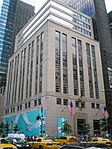Rehs Galleries

Rehs Galleries is an art gallery on 57th Street, Manhattan, New York City. It displays works by 19th century European Barbizon, Realist, Naturalist and Academic works of art with some Impressionism and Post-Impressionism. Mid-20th-century American artists such as Ilya Bolotowsky and Ugo Giannini are represented along with a number of contemporary artists. Rehs Galleries was elected a member of the Fine Art Dealers Association in 1995 . This same year Rehs Galleries moved from the 63rd street premises to its current location at 5 East 57th Street, New York City. In 1991, the gallery began its Julien Dupré and Daniel Ridgway Knight catalogue raisonné projects. In 2003 the gallery began its Emile Munier online catalogue raisonné project and in 2007 the online project for Antoine Blanchard was launched.
Excerpt from the Wikipedia article Rehs Galleries (License: CC BY-SA 3.0, Authors, Images).Rehs Galleries
East 57th Street, New York Manhattan
Geographical coordinates (GPS) Address Nearby Places Show on map
Geographical coordinates (GPS)
| Latitude | Longitude |
|---|---|
| N 40.762777777778 ° | E -73.973055555556 ° |
Address
East 57th Street 9
10022 New York, Manhattan
New York, United States
Open on Google Maps






